Ett faerligt frieri (1919)

Swedish postcard by Axel Eliassons Konstförlag, Stockholm, No. 140. Photo: Skandia Film, Stockholm. Lars Hanson and Gull Cronvall in Ett farligt frieri/A Dangerous Proposal (Rune Carlsten, 1919).

Swedish postcard by Axel Eliassons Konstförlag, Stockholm, no. 141. Photo: Skandia Film, Stockholm. Lars Hanson and Gull Cronvall in Ett farligt frieri/A Dangerous Proposal (Rune Carlsten, 1919).
The story of Ett farligt frieri/A Dangerous Proposal/A Dangerous Wooing (Rune Carlsten, 1919) deals with Tore (Lars Hanson), a smallholder's son, secretly in love with Aslaug (Gull Cronvall), the most beautiful girl in the village. Many boys are after her, but Knut (Theodor Blich) and his two sons drive them away if they come too close to the farm.
When Tore asks for Aslaug's hand, her father just laughs at him. Knut has ambitious plans to marry her to the son of the wealthiest farmer around. Even after Knut and Aslaug's brothers have beaten Tore black and blue, he persists in visiting Aslaug, even climbing a giant wall of rock...
The restored version of Ett farligt frieri was shown in 2018 at the Giornate del Cinema Muto in Pordenone, Italy. See Antti Alanen's blogpost on the film.

Swedish postcard by Axel Eliassons Konstförlag, Stockholm, no. 143. Photo: Skandia Film, Stockholm. Lars Hanson and Gull Cronvall in Ett farligt frieri/A Dangerous Proposal/A Dangerous Wooing (Rune Carlsten, 1919).

Swedish postcard by Axel Eliassons Konstförlag, Stockholm, no. 144. Photo: Skandia Film, Stockholm. Lars Hanson and Gull Cronvall in Ett farligt frieri/A Dangerous Proposal/A Dangerous Wooing (Rune Carlsten, 1919).
Sången om den eldröda blomman (1919)
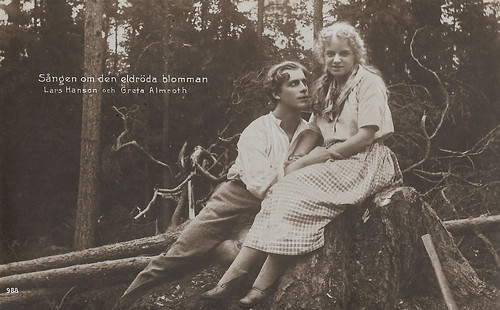
Swedish postcard by Forlag Nordisk Konst, Stockholm, no. 988. Photo: Svenska Biografteatern, Stockholm. Lars Hanson and Greta Amroth in Sången om den eldröda blomman/Flame of Life (Mauritz Stiller, 1919).

Swedish postcard by Forlag Nordisk Konst, Stockholm, no. 989. Photo: Svenska Biografteatern, Stockholm. Lars Hanson and Lillebil Christensen in Sången om den eldröda blomman/Flame of Life (Mauritz Stiller, 1919).
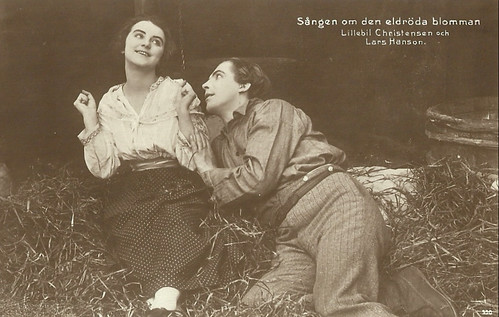
Swedish postcard by Nordisk Konst, no. 990. Photo: Svenska Biografteatern, Stockholm. Lars Hanson and Lillebil Christensen in Sången om den eldröda blomman / The Song of the Red Flower (Mauritz Stiller, 1919).

Swedish postcard by Forlag Nordisk Konst, Stockholm, no. 991. Photo: Svenska Biografteatern, Stockholm. Lars Hanson and Louise Fahlmann in Sången om den eldröda blomman/Flame of Life (Mauritz Stiller, 1919).
According to Swedish Wikipedia, Sången om den eldröda blomman/Flame of Life (Mauritz Stiller, 1919) premiered on 14 April 1919. It was shot at the Svenska Biografteatern film studio at Lidingö, with exterior scenes at the Faxälven river near Långsele, near Sollefteå. Cinematography was by Ragnar Westfelt and Henrik Jaenzon. Armas Järnefelt, a Fin but naturalised Swede and a famous opera composer and conductor, wrote a special film score (his first) for this film, based on Finnish and Swedish folk songs.
Sången om den eldröda blomman/Flame of Life was based on the Finnish novel 'Laulu tulipunaisesta kukasta' (The Song of the Red Flower, 1905) by Johannes Linnankoski. The film became a big popular success and ran for five weeks at the premiere cinema Röda Kvarn in Stockholm, which never had happened before. The net profit of the film was at least $ 80,000, the biggest profit to date for any Swedish film.
The story deals with Olof Koskela (Lars Hanson), the restless son of a wealthy farmer, who at a dance night abandons his girl Anniki (Greta Almroth) for a maid, Elli (Lillebil Christensen), to the consternation of his parents. His mother (Louise Fahlman) almost catches him in the act. A fight breaks out between Olof and his father, after which he has to leave home. Olof joins a group of raftsmen and follows them down the river.
There he meets Kyllikki (Edith Erastoff), but to his surprise, she dismisses him as another landlubber. Then he decides to show that he is not just anyone. The next Sunday, he stakes out the rapids on a log in front of large crowds of spectators along the river and the long rapids. No one has yet dared to run the rapids on a log. But Olof succeeds and at the last minute, he jumps ashore, while the log swirls around down the fall at the foot of the rapids.
That evening, Kyllikki is waiting for him in the forest. When they part the next morning, she says: "When your years of wandering are over, come back. I will wait for you." Olof arrives in the big city and meets Elli again, who has now ended up in a brothel. He is shocked. Eventually, he comes to his senses and returns to his hometown. Both his parents are now dead, and when he seeks out Kyllikki, her father wants nothing to do with him. But then Kyllikki, as stubborn as her father, declares that in that case, she will leave home. Olof and Kyllikki settle down at the Koskela farm. The wanderer has finally found peace.
In June 2019 the restored and sonorised version with an orchestra performing Jarnefelt's music of Sången om den eldröda blomman was shown at the Cinema Ritrovato festival in Bologna, Italy. See Antti Alanen's excellent blogpost. Alanen quotes Swedish Film Archive curator Jon Wengstrom: "As the carefree Olof who finally finds peace within himself, Lars Hanson gives one of the best performances of his career; not least in the scenes where a disillusioned Olof visits bars and brothels in the city. The dialogue with his image in the mirror of a bar is one of the highlights of staging and acting in the film." We were present at this screening and fully agree with Wengstrom.

Swedish postcard by Forlag Nordisk Konst, Stockholm, no. 992. Photo: Svenska Biografteatern, Stockholm. Lars Hanson and Edith Erastoff in Sången om den eldröda blomman/Flame of Life (Mauritz Stiller, 1919).

Swedish postcard by Forlag Nordisk Konst, Stockholm, no. 993. Photo: Svenska Biografteatern, Stockholm. Lars Hanson in Sången om den eldröda blomman/Flame of Life (Mauritz Stiller, 1919).
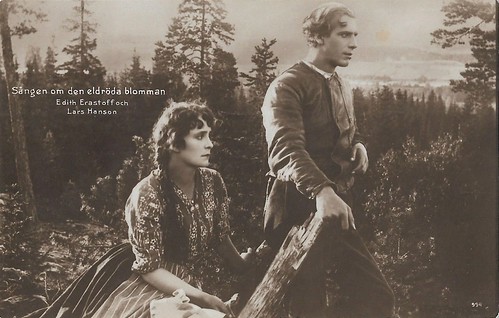
Swedish postcard by Forlag Nordisk Konst, Stockholm, no. 994. Photo: Svenska Biografteatern, Stockholm. Lars Hanson and Edith Erastoff in Sången om den eldröda blomman/Flame of Life (Mauritz Stiller, 1919). Before Olaf and Kylikki part, she says to the restless man: "When your years of wandering are over, come back. I will wait for you."

Swedish postcard by Forlag Nordisk Konst, Stockholm, no. 995. Photo: Svenska Biografteatern, Stockholm. Lars Hanson and Doris Nelson in Sången om den eldröda blomman/Flame of Life (Mauritz Stiller, 1919). Olof Koskela meets a streetwalker in the city, still unaware that his former beloved Elli now works in a brothel too.
Erotikon (1920)
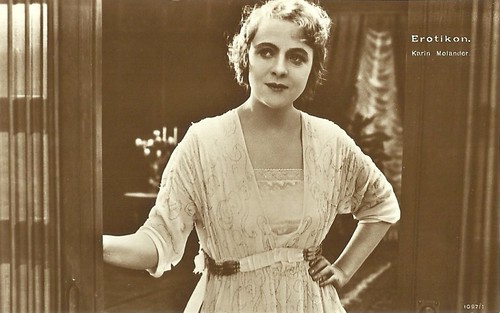
Swedish postcard by Nordisk Konst, Stockholm, no. 1097/1. Photo: Svensk Filmindustri. Karin Molander in Erotikon/Bounds That Chafe (Mauritz Stiller, 1920).

Swedish postcard by Nordisk Konst, Stockholm, no. 1097/2. Photo: Svensk Filmindustri. Anders de Wahl and Karin Molander in Erotikon (Mauritz Stiller, 1920).
In the romantic comedy Erotikon/Bounds That Chafe (Mauritz Stiller, 1920), the story revolves around an entomology professor obsessed with the sexual life of bugs, and his easygoing wife who is courted by two suitors. Marthe (Karin Molander) is secretly in love with her uncle, prof. Carpentier (Anders de Wahl), while his wife Irene (Tora Teje) loves baron Felix (Vilhelm Bryde). Her husband's friend, the sculptor Preben Wells (Lars Hanson), loves Irene. Carpentier doesn't oppose his wife's flirts as he likes somebody else too.
Erotikon, based on the 1917 play 'A kék róka' by Ferenc Herczeg, pushed the boundaries of what was acceptable on the screen in 1920. Director Mauritz Stiller obviously delighted in teasing his audience with each scandalous plot twist and every salacious leer, and the result is a deliciously subversive comedy that was very much ahead of its time. The film premiered in Sweden on 8 November 1920. It became a commercial success and was sold to 45 markets abroad.

Swedish postcard by Nordisk Konst, Stockholm, no. 1097/3. Anders de Wahl and Karin Molander in Erotikon/Bounds That Chafe (Mauritz Stiller 1920).

Swedish postcard by Nordisk Konst, Stockholm, no. 1097/6. Photo: Svensk Filmindustri. Tora Teje and Lars Hanson in Erotikon (Mauritz Stiller, 1920).
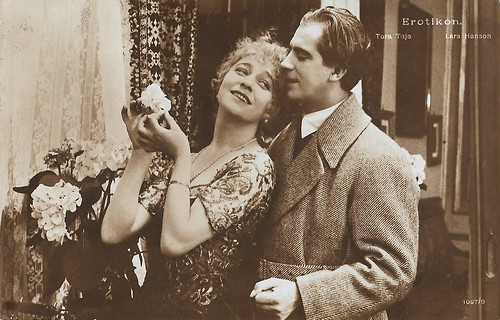
Vintage Swedish postcard by Nordisk Konst, Stockholm, no. 1097/9. Photo: Svensk Filmindustri. Tora Teje and Lars Hanson in Erotikon (Mauritz Stiller, 1920).
Sources: Wikipedia (Dutch, Swedish and English) and IMDb.
No comments:
Post a Comment